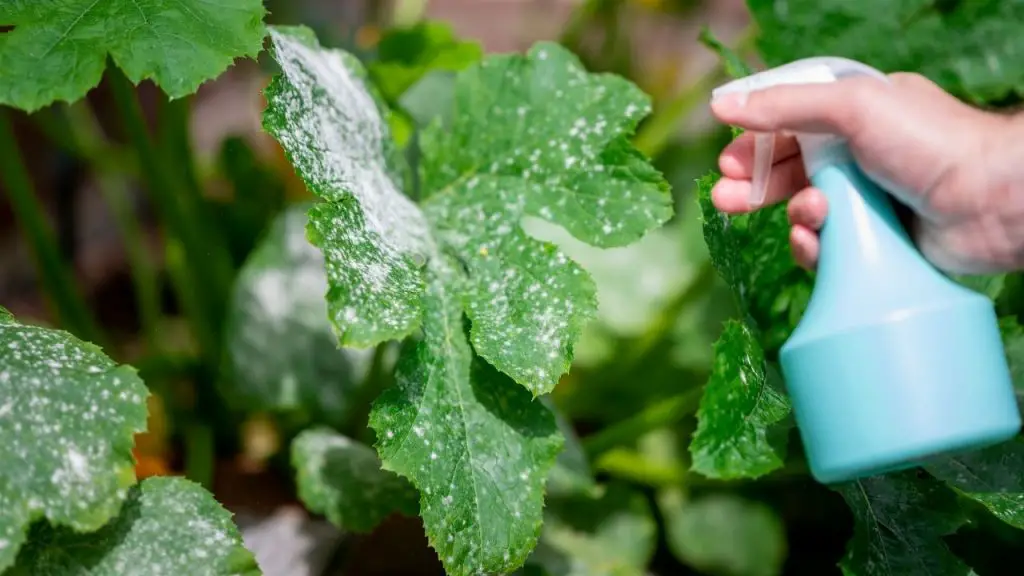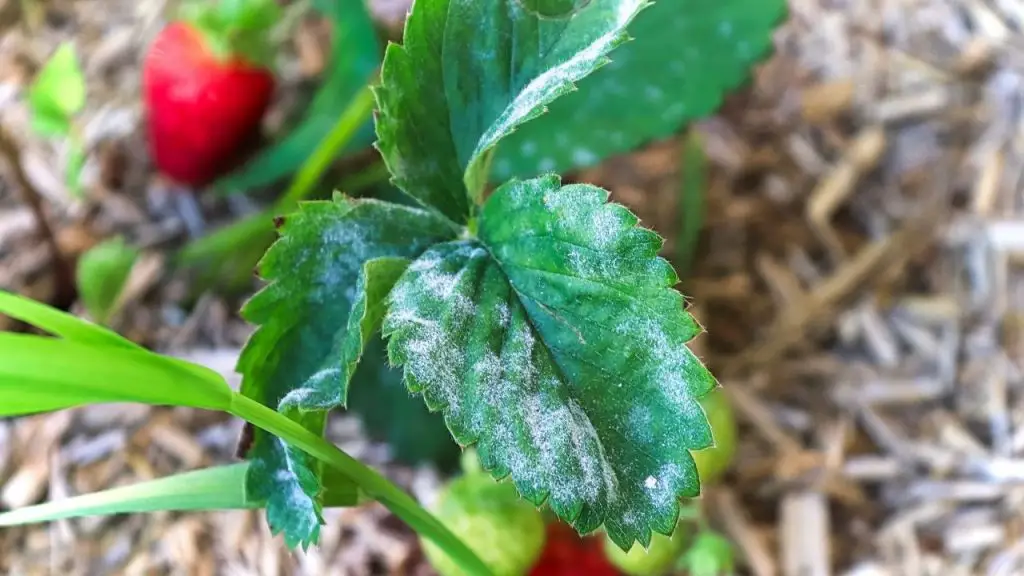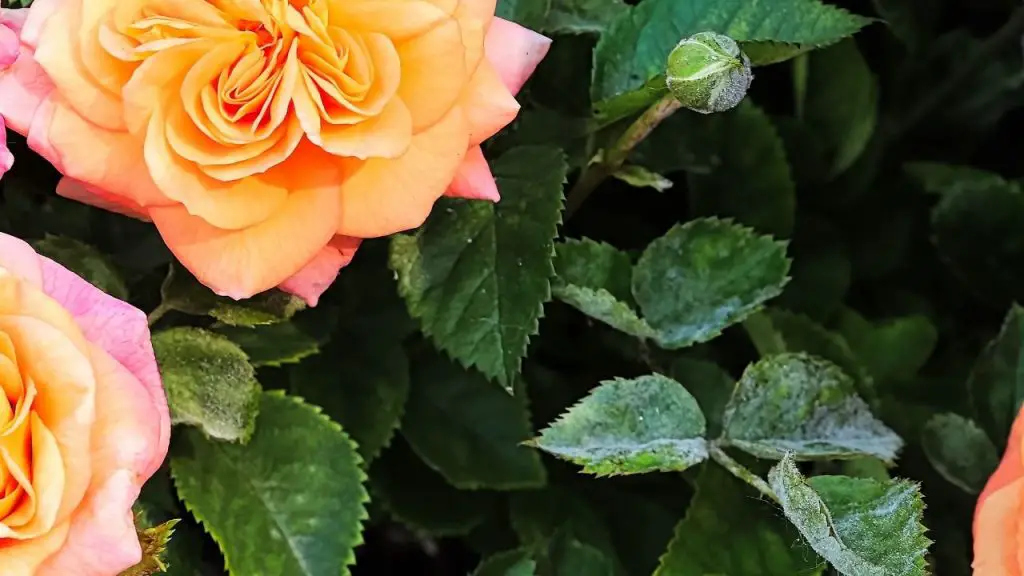Powdery Mildew on Plants is the most prominent plant disease which affects all parts of the plants right from the buds, the surface of leaves to the fruits and flowers. They are small white bugs on plants (Similar to Whiteflies) covering various parts of like leaves, stem, flower, buds.

It’s a real pain for most garden lovers. Let us find out quickly How To Get Rid Of Powdery Mildew with [15] Easy Yet Effective Ways.
It is caused by fungi, Sphaerotheca, Podosphaera, Uncinula, Microsphaera, Erysiphe, and Phyllactinia. It is a common fungal infection that affects almost all types of plant species.
What Is Powdery Mildew? And Its Harms On Plants.
What are tiny white bugs? this is the most obvious question one can ask. They are Powdery mildew, which is the white spots on leaves, powdery layer. They are part of APHIDS (APHIDIDAE FAMILY).
And tiny white bugs on the leaves surface of the plant’s parts, which restricts the plant’s growth. It highly affects the leave’s lower area.
If we are unconcerned about the infections, these powdered mildew spots will develop sexual pores in the plant, restricting its growth after a few days.

This powdery mildew usually affects the baby leaf or the bud before it unfurls its petals. Simulating the young leafy petals makes it curl and shrink itself forbidding the further growth of the plant.
Mildew on plants will significantly affect the leaves and cause pores on the leaflet and leaves to turn brown and finally fell. The Powdery Mildew on plants will not affect the matured parts of the plant.
Also read-
- How To Get Rid Of Mealybug Eggs In Soil [21 Affordable Ways]
- Quick Help! How To Identify And Get Rid Of Springtails Bugs Without Any Toxic Sprays
- How To Thrips Control Within (24 Hrs) Naturally (Without Toxic Sprays)
What Causes Powdery Mildew?
- The growth of Fungi is the main reason for the powdery mildew. The mildew indicates the influence of fungus on the plant.
- Amongst other species of Fungi podosphaera xanthii with Erisiphales is the most common indicator of White Powdery Mildew.
- The fungus reduces the water absorption level from the soil resulting in humidity, which leads to such disease in plants.

How Do I Prevent Powdery Mildew On Plants?
Once you discover what are little white bugs? Now it’s time to get rid of them permanently. The prolific steps to be followed meticulously are given below to prevent Powdery Mildew on Plants.
- Always choose a powdery mildew-resistant plant to grow in your garden.
- Plants like cucumber, squash, pumpkins, peas, melon, and so on are some of the powdery mildew resistants.
- Keep the plants more exposed to sunlight; it restricts the growth of mildew.
- Always keep the plants in the area, ensuring ventilation to avoid humidity on the surface.
- Watering from top to bottom thoroughly, perhaps without watering much. It may wash off the Powdery mildew from leaves.
What Are Powdery Mildew Symptoms?
The pale yellow colored pores with the white powdery mildew affect the plants to a greater extent. The symptoms are
- Firstly a pale yellow colored spot will be developed on the surface of the leaf.
- The powdery layer will be spotted on and below the surface of the parts of the plants.
- The powdery mildew covers the entire leaf or buds or the flower petals.
- As the powdered layer covered the counterparts, the fruit ripens before it gets matured.
- Thus White Powdery mildew weakens the plants.
Best Fungicide For Powdery Mildew
The experts recommended exceptional fungicides that are effective against infections and prevent the plants from decaying.
The following are the most prominent fungicides used commonly to get rid of White Powdery mildew.
- Bayer Advanced
- Multipurpose copper fungicide
- Scotts Lawn Fungicide
- Immuox multipurpose fungicide
- Ferti-Loms liquid Fungicide
- Bonide811 fungicide
- Potassium Bicarbonate fungicide
- Daconil fungicide
These were some of the recommended fungicides in the market.
How Can Powdery Mildew Be Cured?
If your plant is affected, treat the infected area initially by using any one of the recommended fungicides on the market.
- Sulfur or Copper Based Fungicides: These kinds of fungicides will help you get cured of the parasitical disease. To possess an effective and quick result, sprinkle it in the affected areas for more than 7 to 10 times a day with a particular interval of time.
- Serenade Garden: The method which is unique and useful to treat the powdery mildew on Plants. It kills the plant’s diseases to a greater extent within two weeks of continuous application. Add 1 to 2 tablespoon of the solution with one gallon of water, apply the mixture to all parts of the plants, and cover the entire plant.
- Monterey BI-CARB: it is a similar product to serenade garden, which is also useful when applied by mixing the four teaspoons of the concentrated solution with 2 gallons of water. It kills the fungus on the infected area, which clears the White Powdery Mildew on the plant.
- Green Cure Fungicide: It is a distinctive solution to treat infections. The solution is the mixture of potassium bicarbonate, which kills the infections and let the plant grow without restrictions. Like other solutions, a 1 to 2 tablespoon of this solution mixed with water and gently on the affected areas will effectively clear the infections.
- Zero Tolerance And SNS 244: These are the fungicides that are prepared by using food ingredients. It not only cures but also adds nourishment by acting as a resistance and restricting the new infections’ attack.
Powdery Mildew Baking Soda Vs. Milk
To get rid of powdery mildew, soda and milk both are effective. Baking soda, which is very useful in killing fungi infections, clears the White mold on leaves.
As the fungi are the significant reason for the arrival of Powdery Mildew. When applied by mixing with water, milk is also equally potential to kill the infections.
But milk can ensure better nourishment. Moreover, it enriches the soil and prevents the disease from spreading.
Can We Use Apple Cider Vinegar For Powdery Mildew
Utilizing Apple Cider Vinegar is the most ancient method to get rid of Powdery mildew from the plants.
- The regular methods when Apple Cider Vinegar’s two teaspoon is mixed with clean water.
- Or, three tablespoons of vinegar (44 ml) with 1 gallon (3.8 liters) of water.
- Sprinkle the mixture entirely from the overhead to ensure it covers the whole part of the plant. It kills the infections and helps the plant to grow healthier.
Traditionally we use vinegar to treat the disinfectants. It acts as a cleansing agent to kill germs. To kill Powdery Mildew, vinegar is more effective and harsher against infections.
Check and evaluate before sprinkling the vinegar solution in the plant. Check by pouring the liquid into the affected area to ensure it doesn’t possess any side effects. Pour an ample amount of vinegar onto the plant to have better nourishment and growth.
It kills the fungi, which is the root cause of the powdery mildew. To get rid of Powdery Mildew, diluted vinegar will be the best and consistent remedy. Ensure that it is diluted before pouring as the concentrated vinegar may be harsh in the saplings’ budding roots.
Will Hydrogen Peroxide Kill Powdery Mildew?
The powdery mildew affects the plants like a parasite. It spread all over the parts and restricts the growth to a greater extent. It could also create pores on the leaf and turns brown and decay.
The hydrogen peroxide will help you mend your plant without side effects and eliminate the white mold on the leaves. The steps to be followed while using the hydrogen peroxide as the natural resistance are as follows,
- First and foremost, remove the highly infected part of the plant. Chop off the affected areas to restrict the infection from spreading. Dispose of it by maintaining proper measures to avoid circumstances.
- Mix a quart of three percentile of robust hydrogen peroxide solution with 3 quarts of water. Blend well the solution and pour it into the spray bottle. Spraying the solution in the entire part of the plants ensures better nourishment, curing the pores and infections.
- Apply the hydrogen peroxide solution in the most affected area to get rid of powdery mildew without affecting the plants’ roots or other sensitive parts.
- Regular application of hydrogen peroxide on the affected areas will result in significant and consistent growth. It also restricts the arrival of new infectious diseases after a dew interval of time.
What Are The Home Remedies For Powdery Mildew?
There are many recommendations, and precautionary treatments suggested every day to get rid of fungal infections in the plants. The most prominent way is to utilize Baking soda, mouthwash, water, milk.
And much more homely ingredients are used in a better way to get rid of White Powdery Mildew. These are an eco-friendly approach to the plants in treating such infections without the usage of chemicals.
Let’s ponder over the effective ways to use these ingredients to possess healthy plant sampling.
Baking Soda:
- It is harsh and effective against fungal infections. Baking soda mixed with liquid detergent and water, the perfect mixture will help your plants get rid of White Powdery Mildew, and it enhances the growth of young leaflets without any infections.
- Another useful combination with baking soda is mixing a tablespoon of baking soda and one and a half teaspoon of non-detergent soap liquid with a gallon of water. Gentle spraying will help you kill the infections and the Powdery Mildew Pores without harming the buds or the leaflets.
Mouthwash:
- Usually, mouthwash is used to cleanse the mouth by rinsing it. But it is highly effective and efficient in killing the germs in the saplings. It has the immense potential to destroy the Powdery Mildew before it could create pores on the surface.
- Mixing one part of mouthwash liquid with three-part of water and sprinkling the mixture on the plants will kill the infectious germs and eradicates the White Powder Mold on the Plants.
Milk:
- Milk is the most significant and distinctive ingredients to kill the microorganisms. It acts as an exceptional fungicide and effective Powdery Mildew Prevention. Alongside it also adds up nutrients to the budding saplings to grow healthier.
- Mix a part of the milk with three equal parts of water and gently sprinkle on the surface, which is affected generally. It is the best method to destroy the infections and save the plants too.
- This approach’s main benefit is that it neither consists of detergent nor chemicals, which can cause harm. It is more effective in plants like cucumber, zucchini, and squash.
Water:
- It is the most recommended eco-friendly approach to treat the infected plants without creating an extreme scenario.
- Proper watering the plants from top to bottom from overhead ensures infection-free growth. Make sure you don’t water the excess amount of water.
- It may result in humidity, which is the main reason for the occurrence of Powdery Mildew Disease.
How To Get Rid Of Powdery Mildew During Flowering?
Powdery mildew is the most severe issue which is faced by the people of today’s scenario.
rid of those infections is most essential to have a healthy plant. To get rid of the fungi effectively, follow the simple steps to be followed with the right choice of fungicides.
The main ways include chopping the affected areas and pouring the diluted solution regularly to get rid of these issues consistently.
Also, read the below tips.
- How To Add Calcium To Soil [21 Working Ways] Exclusive Guide
- (21 Exclusive Ways) How To Prune Grape Vines -Beginners Guide
- How + When To Prune Raspberries For Winters Exclusive [21 Ways]
- How To Grow Roses From Seeds [All Types Of Roses]- Complete Growing Guide
How To Get Rid Of Powdery Mildew On Squash?
Organic powdery mildew solution in the squash, follow specific techniques and methodology to avoid losing the entire plant.
Planting the saplings at a certain distance will ensure infection-free growth with enrichment in nutrients. Regular application of fungicides is required to prevent White powdery mildew in the squash.
- Proper and regular inspection of the plants is necessary to avoid the infections spreading to other parts of the plant.
- Eradicating the diseases at the early stage is the best remedy than looking for the fungicides later.
- And sulfur oil should be applied to avoid such infections as it nourishes and enriches the roots and stem. Neem oil also can be used in the plant to get rid of powdery mildew in the squash.
Conclusion
The well-known methods followed to grow the plants without fungi infections will help you to possess healthy plants. Continuous watering and regular care assist the plants to get rid of powdery mildew.
Prohibiting the fungal infections will restrict the occurrence of White Mold on the Plants, as the fungi are the natural stimulant of Powdery Mildew.
Thus, the depicted ecofriendly strategies will help you to possess healthy plants without White Powdery Mildew.

My name is Olivia, and I live in the United States and love having plants in my garden. Lots of plants are there on my balcony, indoor and outdoor garden also. Here I am trying to share useful gardening tips, how to grow and care for various plants, etc.
